Chufeng Xiao
PartHOI: Part-based Hand-Object Interaction Transfer via Generalized Cylinders
Apr 29, 2025Abstract:Learning-based methods to understand and model hand-object interactions (HOI) require a large amount of high-quality HOI data. One way to create HOI data is to transfer hand poses from a source object to another based on the objects' geometry. However, current methods for transferring hand poses between objects rely on shape matching, limiting the ability to transfer poses across different categories due to differences in their shapes and sizes. We observe that HOI often involves specific semantic parts of objects, which often have more consistent shapes across categories. In addition, constructing size-invariant correspondences between these parts is important for cross-category transfer. Based on these insights, we introduce a novel method PartHOI for part-based HOI transfer. Using a generalized cylinder representation to parameterize an object parts' geometry, PartHOI establishes a robust geometric correspondence between object parts, and enables the transfer of contact points. Given the transferred points, we optimize a hand pose to fit the target object well. Qualitative and quantitative results demonstrate that our method can generalize HOI transfers well even for cross-category objects, and produce high-fidelity results that are superior to the existing methods.
CustomSketching: Sketch Concept Extraction for Sketch-based Image Synthesis and Editing
Feb 27, 2024Abstract:Personalization techniques for large text-to-image (T2I) models allow users to incorporate new concepts from reference images. However, existing methods primarily rely on textual descriptions, leading to limited control over customized images and failing to support fine-grained and local editing (e.g., shape, pose, and details). In this paper, we identify sketches as an intuitive and versatile representation that can facilitate such control, e.g., contour lines capturing shape information and flow lines representing texture. This motivates us to explore a novel task of sketch concept extraction: given one or more sketch-image pairs, we aim to extract a special sketch concept that bridges the correspondence between the images and sketches, thus enabling sketch-based image synthesis and editing at a fine-grained level. To accomplish this, we introduce CustomSketching, a two-stage framework for extracting novel sketch concepts. Considering that an object can often be depicted by a contour for general shapes and additional strokes for internal details, we introduce a dual-sketch representation to reduce the inherent ambiguity in sketch depiction. We employ a shape loss and a regularization loss to balance fidelity and editability during optimization. Through extensive experiments, a user study, and several applications, we show our method is effective and superior to the adapted baselines.
Sketch2Stress: Sketching with Structural Stress Awareness
Jun 09, 2023
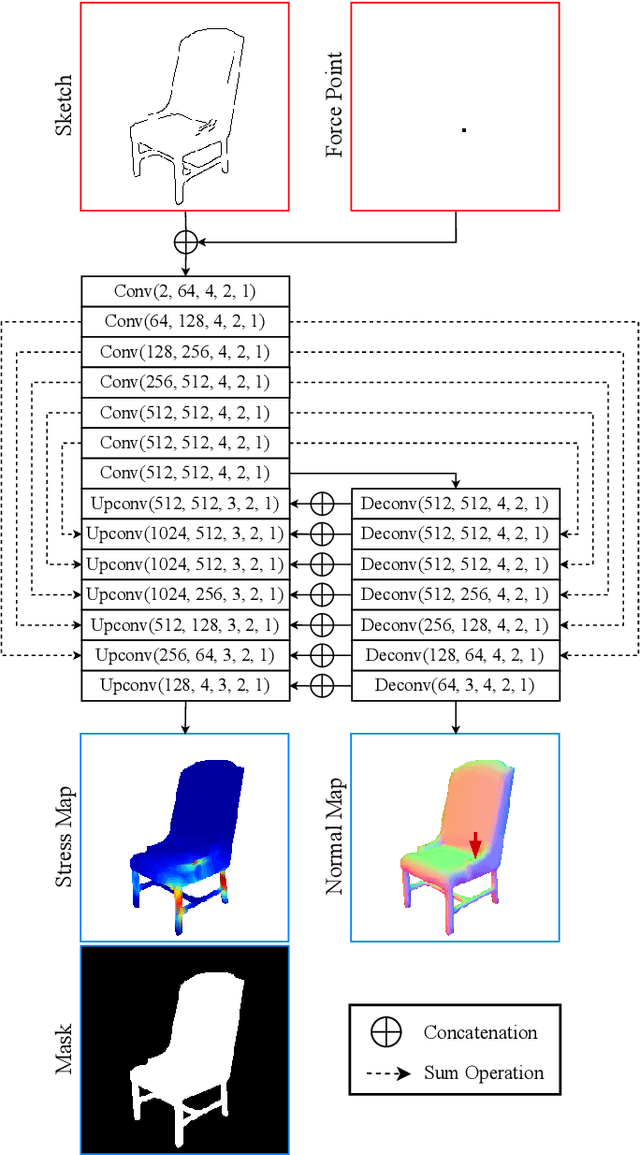
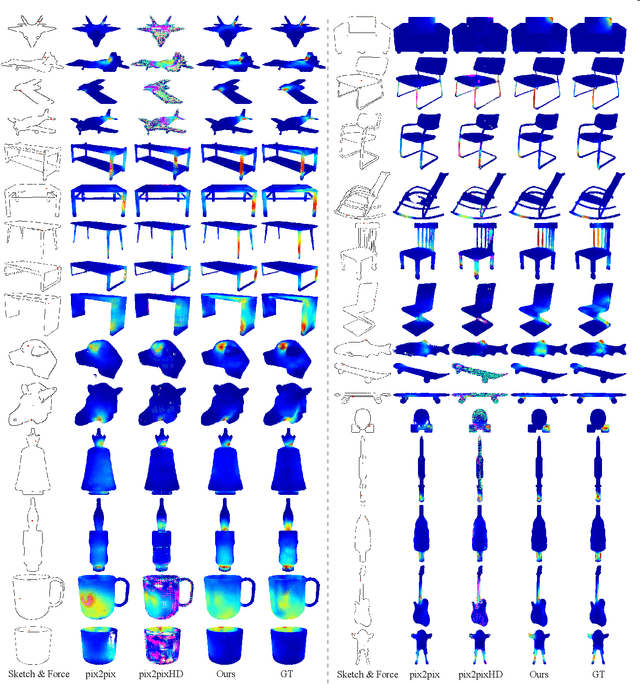

Abstract:In the process of product design and digital fabrication, the structural analysis of a designed prototype is a fundamental and essential step. However, such a step is usually invisible or inaccessible to designers at the early sketching phase. This limits the user's ability to consider a shape's physical properties and structural soundness. To bridge this gap, we introduce a novel approach Sketch2Stress that allows users to perform structural analysis of desired objects at the sketching stage. This method takes as input a 2D freehand sketch and one or multiple locations of user-assigned external forces. With the specially-designed two-branch generative-adversarial framework, it automatically predicts a normal map and a corresponding structural stress map distributed over the user-sketched underlying object. In this way, our method empowers designers to easily examine the stress sustained everywhere and identify potential problematic regions of their sketched object. Furthermore, combined with the predicted normal map, users are able to conduct a region-wise structural analysis efficiently by aggregating the stress effects of multiple forces in the same direction. Finally, we demonstrate the effectiveness and practicality of our system with extensive experiments and user studies.
DifferSketching: How Differently Do People Sketch 3D Objects?
Sep 19, 2022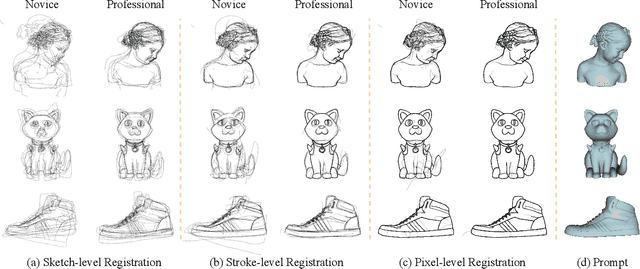

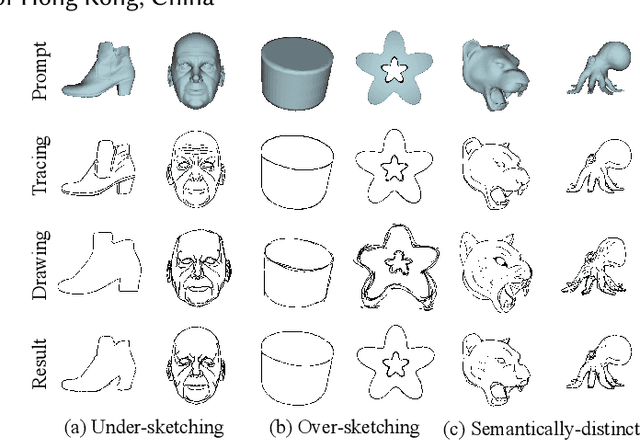

Abstract:Multiple sketch datasets have been proposed to understand how people draw 3D objects. However, such datasets are often of small scale and cover a small set of objects or categories. In addition, these datasets contain freehand sketches mostly from expert users, making it difficult to compare the drawings by expert and novice users, while such comparisons are critical in informing more effective sketch-based interfaces for either user groups. These observations motivate us to analyze how differently people with and without adequate drawing skills sketch 3D objects. We invited 70 novice users and 38 expert users to sketch 136 3D objects, which were presented as 362 images rendered from multiple views. This leads to a new dataset of 3,620 freehand multi-view sketches, which are registered with their corresponding 3D objects under certain views. Our dataset is an order of magnitude larger than the existing datasets. We analyze the collected data at three levels, i.e., sketch-level, stroke-level, and pixel-level, under both spatial and temporal characteristics, and within and across groups of creators. We found that the drawings by professionals and novices show significant differences at stroke-level, both intrinsically and extrinsically. We demonstrate the usefulness of our dataset in two applications: (i) freehand-style sketch synthesis, and (ii) posing it as a potential benchmark for sketch-based 3D reconstruction. Our dataset and code are available at https://chufengxiao.github.io/DifferSketching/.
SketchHairSalon: Deep Sketch-based Hair Image Synthesis
Sep 21, 2021
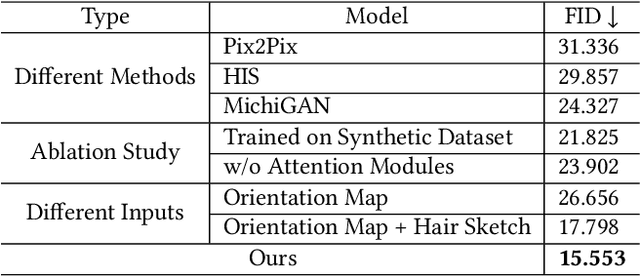
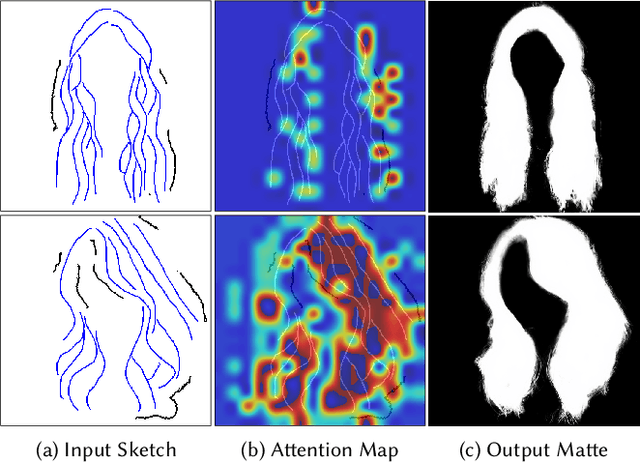
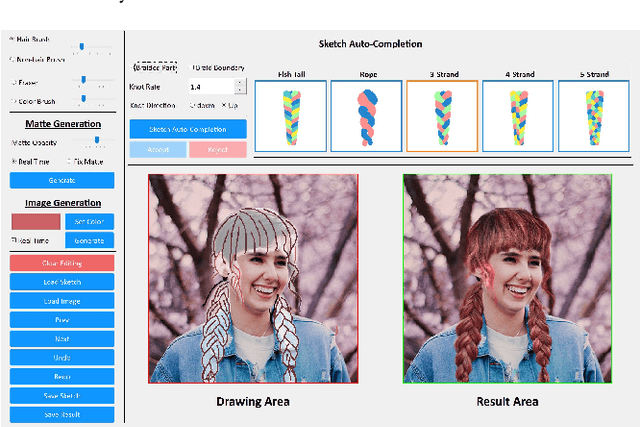
Abstract:Recent deep generative models allow real-time generation of hair images from sketch inputs. Existing solutions often require a user-provided binary mask to specify a target hair shape. This not only costs users extra labor but also fails to capture complicated hair boundaries. Those solutions usually encode hair structures via orientation maps, which, however, are not very effective to encode complex structures. We observe that colored hair sketches already implicitly define target hair shapes as well as hair appearance and are more flexible to depict hair structures than orientation maps. Based on these observations, we present SketchHairSalon, a two-stage framework for generating realistic hair images directly from freehand sketches depicting desired hair structure and appearance. At the first stage, we train a network to predict a hair matte from an input hair sketch, with an optional set of non-hair strokes. At the second stage, another network is trained to synthesize the structure and appearance of hair images from the input sketch and the generated matte. To make the networks in the two stages aware of long-term dependency of strokes, we apply self-attention modules to them. To train these networks, we present a new dataset containing thousands of annotated hair sketch-image pairs and corresponding hair mattes. Two efficient methods for sketch completion are proposed to automatically complete repetitive braided parts and hair strokes, respectively, thus reducing the workload of users. Based on the trained networks and the two sketch completion strategies, we build an intuitive interface to allow even novice users to design visually pleasing hair images exhibiting various hair structures and appearance via freehand sketches. The qualitative and quantitative evaluations show the advantages of the proposed system over the existing or alternative solutions.
 Add to Chrome
Add to Chrome Add to Firefox
Add to Firefox Add to Edge
Add to Edge